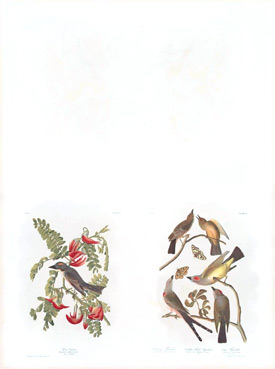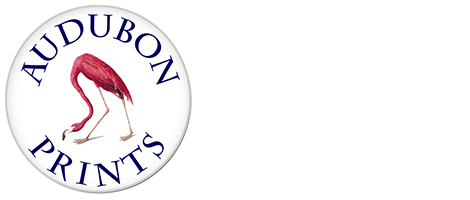 In 1858 or 1859 John Woodhouse Audubon entered upon an ambitious project, that of reproducing the Birds of America at one-half the original price, from the copper plates transferred to stone. Every plate was to be colored from the original drawings. The work was to be issued in forty-five numbers, forty-four of plates and one of text. Printed on seven double-elephant sheets, of the best quality for the purpose, 2’7 by 40 inches, each number was to contain two large plates, each occupying a whole sheet; two of medium size, each also occupying an entire sheet; and six of the smaller size, two on a sheet.
In 1858 or 1859 John Woodhouse Audubon entered upon an ambitious project, that of reproducing the Birds of America at one-half the original price, from the copper plates transferred to stone. Every plate was to be colored from the original drawings. The work was to be issued in forty-five numbers, forty-four of plates and one of text. Printed on seven double-elephant sheets, of the best quality for the purpose, 2’7 by 40 inches, each number was to contain two large plates, each occupying a whole sheet; two of medium size, each also occupying an entire sheet; and six of the smaller size, two on a sheet.
The text was to be properly and scientifically classified so that, when the work was completed, the plates could be placed and bound corresponding with the order of text, in either three or four volumes. However the work was never completed, and only one volume containing 15 numbers of 1o5 double-elephant plates with 150 species was issued. The outbreak of the Civil War, aided, it is believed, by unscrupulous dealings of business partners, resulted in disaster. The publication had been attempted in association with Messrs Roe Lockwood & Son, New York, and the lithographers J. Bien & Company also of New York.2 The lithographer, Julius Bien (1826-1909), was born at Naumberg (near Cassell), Germany. He took part in the Revolution of 1848, one of the group of notable men brought to the United States by that cataclysm. He will be remembered also as the first great scientific cartographer in the United States. During the presidency of Pierce he produced maps of the new surveys of the West. His engravings and lithographs were of the highest quality.
No copy of a prospectus prepared for American subscribers has been located. The one issued for English subscribers stated that the price of each number was to be £2 8s., or roughly $11. The forty-five numbers were to be issued for approximately $5oo, a price which was, as stated in the prospectus, half of $1,000, the price of the original work. The paper used for the publication does not have a watermark.
The personal fortunes of Mrs. Audubon were seriously affected by the failure of her son’s attempt to reproduce the Birds of America. Her older son died in 1859 and the younger died in 1862, within two years after the failure of the publication. It became necessary for the mother to raise funds in the only way left open to her, namely to try to dispose of the original drawings and the copper plates of the Birds of America. The original drawings she was able to sell to the New-York Historical Society in 1863 for $4,000.
On 19 October 1864, when she was in her 76th year, she wrote to Professor Joseph Henry, the first director of the Smithsonian Institution in Washington, in the hope that he might be able to help her sell the copper plates. In the letter the sale of the drawings is touched upon:
The sale was a sacrifice both of the Drawings and my feelings, and cruelly to state nearly the whole of the proceeds past from me soon, for the claims on notes I had indorsed for my unfortunate sons. Now I have the Copper Plates entire of the “Birds of America” which I chiefly depend on for the support of myself and orphan grand daughter.
She was not able to sell the copper plates and most of them were melted.
There is no way of knowing how many copies of the one-volume Bien Chromolithograph edition were published. During the Audubon research 49 copies were located. (See list on next page.) In 1963 a Massachusetts public library sold a copy for $2,100 and this writer knows of a copy sold to a collector about the same time for $3,000. Individual prints when offered, which is rare, are priced from $30 to $500, the latter price being that asked for the “Wild Turkey.”
Chromolithograph Plates
Page 1 No. 1- Plate 1 Wild Turkey
2 1- 2 Virginia Partridge
3 1- 3 Dusky Duck
4 1- 4 Purple Grakle or Common Crow Blackbird
5 1- 5 Towhe Bunting
1- 6 Song Sparrow
6 1- 7 Kentucky Warbler
1- 8 Children’s Warbler
7 1- 9 Sea-side Finch
1- 10 Grass Finch or Bay-winged Bunting
8 2- 1 Mallard Duck
9 2- 2 White headed Eagle
10 2- 3 Yellow-billed Cuckoo
11 2- 4 Blue Jay
2- 5 Crested Purple Finch
2- 6 Pine Grosbeak
2- 7 Wood Thrush
2- 8 Hermit Thrush
2- 9 Ruby crowned Wren
2- 10 American Golden-crested Wren
3- 1 American Crow
3- 2 Mocking Bird
3- 3 Rose-breasted Grosbeak
3- 4 Blue Grosbeak
3- 5 Bohemian Chatterer
3- 6 Cedar Bird
3- 7 Carolina Titmouse
3- 8 Hudson’s Bay Titmouse
3- 9 Marsh Wren
3- 10 Nuttall’s lesser-marsh Wren
4- 1 Pinnated Grouse
4- 2 Black-Winged Hawk
4- 3 Boat-tailed Grackle
4- 4 Orchard Oriole
4- 5 Arctic Tern
4- 6 Sandwich Tern
4- 7 Bachman’s Warbler
4- 8 Swainson’s Warbler
4- 9 Azure Warbler
4- 10 Nashville Warbler
5- 1 Summer or Wood Duck
5- 2 Reddish Egret
5- 3 Belted Kingfisher
5- 4 Purple Martin
5- 5 Red backed Sandpiper
5- 6 Pectoral Sandpiper
5- 7 Least Water-hen
5- 8 Yellow-breasted Rail
5- 9 Yellow poll Warbler
5- 10 Rathbone Warbler
6- 1 Great White Heron
6- 2 Eider Duck
6- 3 Green Heron
6- 4 Crested Grebe
6- 5 Buff breasted Sandpiper
6- 6 Little Sandpiper
6- 7 Barn Swallow
6- 8 Republican or Cliff Swallow
6- 9 Canada Warbler
6- 10 Bonaparte’s Flycatcher
7- 1 Carolina Parrot
7- 2 Pileated Woodpecker
45 7- 3 Night Hawk
46 7- 4 Rusty Grakle
47 7- 5 White-bellied Swallow
7- 5* American Swift
48 7- 6 Carbonated Warbler
7- 6 Yellow red poll Warbler
49 7- 7 Wood Wren
7- 7 Winter Wren Rock Wren
50 8- 1 American Flamingo
51 8- 2 Great Auk
52 8- 3 Red-headed Duck
53 8- 4 White Headed Pigeon
54 8- 5 Columbian Humming Bird
8- 6 Mango Humming Bird
55 8- 7 Black-throated Blue Warbler
8- 7* Blue-grey Flycatcher
56 8- 7 Forked-tailed Flycatcher
8- 8 Tyrant Fly-catcher
57 9- 1 Night Heron or Qua bird
58 9- 2 Red-tailed Hawk
59 9- 3 Gadwall Duck
60 9- 4 Smew or White Nun
61 9- 5 Lincoln Finch
9- 6 Henslow’s Bunting
62 9- 7 Yellow Shank
9- 8 Greenshank
63 9- 9 Razor billed Auk
9- 10 Puffin
64 10- 1 Fish Hawk or Osprey
65 10- 2 Fish Crow
66 10- 3 Black Skimmer or Shearwater
67 10- 4 Yellow-breasted chat
68 10- 5 White-crowned Sparrow
10- 6 White throated Sparrow
69 10- 7 Olive sided Flycatcher
10- 8 Great Crested Flycatcher
70 10- 9 Semipalmated Sandpiper
10- 10 Curlew Sandpiper
71 11- 1 Barn Owl
72 11- 2 Ferruginous Thrush
73 11- 3 Pigeon Hawk
74 11- 4 Common Crossbill
75 11- 5 Small Green Crested Flycatcher
11- 6 Wood Pewee
76 11- 7 Black & Yellow Warbler
11- 8 Bay-breasted Warbler
11- 9 Crested Titmouse
11- 10 Black & White Creeper
12- 1 Brown Pelican
12- 2 Great-footed Hawk
12- 3 Golden-winged Woodpecker
12- 4 American Sparrow Hawk
12- 5 Spotted Sandpiper
12 6 Solitary Sandpiper
12- 7 Wilson’s Fly Catcher
12- 8 Yellow-throated Vireo
12- 9 Prairie Titlark
12- 10 Brown Titlark
13- 1 Black Vulture or Carrion Crow
13- 2 Iceland or Jer Falcon
13- 3 Glossy Ibis
13- 4 Blue Crane or Heron
13- 5 Hooded Warbler
13- 6 Green Black-capt Flycatcher
13- 7 Esquimaux Curlew
13- 8 Great Marbled Godwit
13- 9 Sharp-tailed Finch
13- 10 Mac Gillivray’s Finch
14- 1 White-fronted Goose
14- 2 Ruffed Grouse
14- 3 Red winged Starling or Marsh blackbird
14- 4 Baltimore Oriole
14- 5 Pipiry Flycatcher
14- 6 Arkansaw Flycatcher Swallow Tailed
Flycatcher Says Flycatcher
14- 7 Bewick’s Wren
14- 8 House Wren
14- 9 Chipping Sparrow
14- 10 Field Sparrow
15- 1 Canvas-backed Duck
15- 2 Yellow-crowned Heron
15- 3 Swallow-tailed Hawk
15- 4 Ruby-throated Humming Bird
15- 5 White-eyed Flycatcher or Vireo
15- 6 Red-eyed Vireo
15- 7 Pine Creeping Warbler
15- 8 Solitary Flycatcher or Vireo
15- 9 Ring-necked Duck
15- 10 Scaup Duck
*Plates 6-10 in Number 7 and Plates 7-10 in Number 8 have been misnumbered in the Bien edition.
